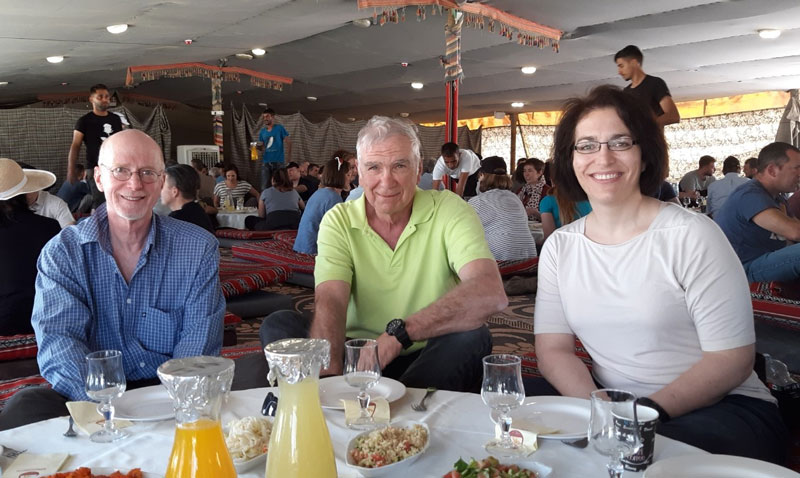Shalom from the SHORESH Meeting in Israel
June 28, 2019 | Download PDF
Senior members from Team TATRC traveled the globe to participate in this year’s SHORESH Meeting, which was hosted by the Israeli Defense Force (IDF) in Tel Aviv and took place 8 – 12 April. COL Gina Adam, TATRC’s Director at the time, attended with both Dr. Jaques Reifman and Dr. Gary Gilbert, who were invited to give specific presentations on their individual areas of expertise.
 The SHORESH Team enjoys a meal. From left: Dr. Jaques Reifman (BHSAI), Dr. Gary Gilbert (MISL), and then-Director COL Gina Adam.
The SHORESH Team enjoys a meal. From left: Dr. Jaques Reifman (BHSAI), Dr. Gary Gilbert (MISL), and then-Director COL Gina Adam.
Dr. Reifman, Director of the Biotechnology High Performance Computing Software Applications Institute, gave a Keynote presentation entitled: “The Role of Artificial Intelligence (AI) in Army Medicine,” as well as a separate presentation on: “Sleep Markers of PTSD in Combat-Exposed Service Members.”
In Dr. Reifman’s second talk on sleep markers of PTSD in Service Members, he discussed the strong evidence linking sleep disturbances and PTSD, even though the identification of objective markers that characterize PTSD during sleep has been challenging, with prior studies yielding inconsistent findings. This research aims to identify quantitative sleep biomarkers of PTSD that are reproducible across nights and sub-populations of a study. The results suggest that these sleep-specific markers may reflect the underlying neural processes involved in PTSD.
Dr. Gary Gilbert, TATRC’s lead for the Medical Intelligent Systems Lab, delivered a presentation on the New Army Research Task Area in Medical Robotic and Autonomous Systems (MED-RAS).
For several years, TATRC and the IDF’s Trauma Branch have looked for opportunities to collaborate and partner on research and development efforts for casualty evacuation in unmanned systems. Beginning in 2010, the USAMRDC collaborated with the IDF through the NATO Human Factors in Medicine (HFM) Panel in publishing a NATO report on Safe Ride Standards for Casualty Evacuation Using Unmanned Aerial Vehicles. Several other reciprocal visits from stakeholders have been held over the past five years, and Israel is a partner-nation and member of the ongoing NATO HFM Exploratory Team studying NATO potential for Autonomous Tactical Care & Evacuation.
During his talk, Dr. Gilbert pointed out that future combat strategies such as the U.S. Army’s Multi-Domain Operations (MDO) will involve greater dispersion and near isolation over great distances necessitating units to be more self-sufficient and less dependent on logistical support. Numbers of manned evacuation platforms are likely to be insufficient for widespread multiple domain battlefields with peer adversaries or may be denied entry. Combat commanders with mounting sick or wounded will face degradation of medical resources and encumbered combat mobility without new combat casualty care and force multiplication strategies. Following the guidance of the U.S. Army’s Robotic and Autonomous Systems (RAS) Strategy, and the 2018 RAS Interim Capability Document, the MRDC’s Medical Simulation & Medical Sciences Research Program (MSISRP) MED-RAS research task area aims to leverage RAS to support prolonged care & evacuation in MDO in collaboration with related research portfolios funded by MRDC’s Combat Casualty Care Research Program. Subsequent to the SHORESH meeting, TATRC, along with the U.S. Army PEO Aviation, the Army Missile Research Development and Engineering Command and the Office of Naval Research, submitted a proposal through the Army’s Foreign Comparative Testing process in coordination with the IDF for the evaluation of Israel’s Cormorant Unmanned Aerial System as a candidate for medical operations in Unmanned Air Systems joint Foreign Technology Assessment. According to Dr. Gilbert, that proposal was not selected for funding this year but the future joint research endeavors with the IDF in this area will be pursued.
The clear highlight of the SHORESH Combat Casualty Care Working Group, to which Dr. Gilbert was assigned, was a visit hosted by the IDF to the heavily fortified and continually defended border between Israel and Syria at the Golan Heights followed by a tour of the nearby supporting hospital center. Unlike the U.S. military, Israel does not operate military-only Role 4 and 5 hospitals, but leverages nearby civilian facilities to support operational missions around its borders. Dr. Gilbert remarked that, “Just off the main road, through seemingly peaceful populated areas, it was a clear reminder of what it’s like to live your entire life under the threat of imminent war on your doorstep.”
Now in its 19th year, SHORESH brings together top scientists and researchers from both the U.S. and Israel in order to find solutions to issues involving the pillars of advancing military medicine. TATRC was honored to be included on the agenda at this year’s event.
This article was published in the November 2019 issue of the TATRC Times.